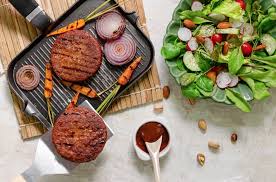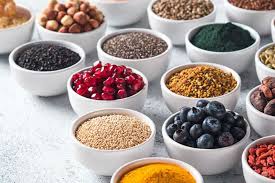Advertisements
The flexitarian diet has been gaining more and more followers due to its balanced and sustainable approach, combining the best of both worlds: meat and vegetables. This eating style stands out for promoting a healthy lifestyle without imposing extreme restrictions. With growing concern about the environmental impact of our food choices, flexitarianism presents itself as a viable and conscious solution for those who want to make a difference.
This guide will explore the nuances and benefits of adopting a flexitarian diet. As you read, you will discover how moderation in meat consumption can be beneficial not only for your body, but also for the planet. Recent data and studies will be presented, demonstrating how this practice can contribute to reducing your carbon footprint and preserving natural resources.
Advertisements
In addition to the environmental benefits, the flexitarian diet offers significant health benefits, such as reducing the risk of chronic diseases and strengthening the immune system. Practical tips and tasty meal suggestions will be shared to help you transition to this lifestyle. By combining culinary creativity with smart choices, you can achieve a nutritious and delicious diet.
Adopting the flexitarian diet is more than just a passing trend; it’s an invitation to rethink your eating habits in a conscious and responsible way. By the end of this content, it will be clear how small changes can have a big impact, both on your personal health and on the environment. It’s time to consider this innovative dietary journey and find the perfect balance between meat and vegetables. 🌿🥩
Advertisements

What is the Flexitarian Diet?
The flexitarian diet is a concept that is increasingly gaining ground among those seeking a balanced and sustainable diet. The term “flexitarian” combines the words “flexible” and “vegetarian”, indicating that this diet allows for a certain flexibility in meat consumption, without giving up a predominantly plant-based diet. This approach can be an excellent option for those who want to reduce their meat consumption, but are not ready to eliminate it completely from their diet.
The flexitarian diet focuses on plant-based foods such as fruits, vegetables, whole grains, nuts, and seeds, but allows for the occasional inclusion of meat and animal products. This not only contributes to personal health, but also has a positive impact on the environment by reducing the carbon footprint associated with meat production. 🍃
Benefits of the Flexitarian Diet
One of the main benefits of the flexitarian diet is the positive impact it can have on cardiovascular health. Studies show that diets rich in vegetables and low in processed meats are associated with a significant reduction in the risk of heart disease. Including more fruits, vegetables and whole grains in your diet can help improve cholesterol and blood pressure levels, which are important markers of cardiovascular health.
Another important benefit is promoting a healthy weight. The flexitarian diet, being high in fiber and low in empty calories, helps keep you feeling fuller for longer, which can result in lower overall calorie intake throughout the day. This is essential for weight management, as balancing calories in and calories out is key to maintaining or achieving a healthy weight.
Additionally, the flexitarian diet can contribute to the health of the planet. The environmental impact of meat production is significant, and reducing meat consumption can help reduce greenhouse gas emissions and deforestation. By adopting a diet that prioritizes plant-based foods, you are not only taking care of your health, but also the environment.
Recommended Articles
How to Start the Flexitarian Diet
If you’re considering adopting a flexitarian diet, the first step is to start small. You don’t have to completely eliminate meat from your diet all at once; instead, try to make small, gradual changes. For example, you could start with one meat-free day per week and gradually increase the frequency as you feel comfortable.
Planning is key to success. Try to prepare your meals in advance, ensuring that you have nutritious and tasty options available. This could include preparing fresh salads, vegetable soups, and whole grain dishes. Variety is important to ensure that you are getting all the nutrients you need.
Experiment with new recipes and ingredients. One of the most fun aspects of the flexitarian diet is the opportunity to explore new flavors and textures. Try including foods you might not eat regularly, like quinoa, lentils, chickpeas, and tofu. 🥗
Top Foods in the Flexitarian Diet
In the flexitarian diet, certain foods play a central role. Here are some of the main components that should be present in your eating plan:
- Vegetables and Greens: These are the foundation of any healthy diet. Choose a variety of colors and types to ensure you get a wide range of nutrients.
- Fruits: Rich in vitamins, minerals and antioxidants, fruits are essential for health. Include a serving of fresh fruits in your daily meals.
- Whole Grains: Foods like brown rice, quinoa, oats, and barley provide fiber and are more nutritious than their refined versions.
- Nuts and Seeds: They are excellent sources of healthy fats, protein and minerals. Try including a small portion in your meals or as a snack.
- Legumes: Beans, lentils and chickpeas are sources of protein and fiber, essential for the flexitarian diet.
- Products of Animal Origin: Include lean meats and dairy in moderation, prioritizing quality and sustainability.
These foods not only help create balanced and nutritious meals, but also contribute to more sustainable and ethical eating.
Tips for Staying Motivated
Staying motivated when adopting a new diet can be challenging, especially when it involves significant changes in eating habits. Here are some tips to help you stay on track with the flexitarian diet:
Set realistic goals: Start with small, achievable goals, like adding an extra serving of vegetables to your plate or replacing one meat-based meal with a vegetarian meal each week. This will help create a sense of success and ongoing motivation.
Involve friends and family: Sharing your journey with people close to you can be a great way to get support and encouragement. Cooking together or sharing recipes can make the experience more enjoyable and inspiring. 👨👩👦
Try new dishes regularly: Monotony can lead to disinterest, so try to vary your meals whenever possible. Look for inspiration in cookbooks, blogs or even on social media for new culinary ideas.
Track your progress: Keeping a food journal can help you identify patterns and areas for improvement, and it can also serve as a reminder of how far you’ve come. Celebrating small victories can be a great way to stay motivated.
With these tips, you'll be on your way to integrating the flexitarian diet into your life in a satisfying and lasting way.
Conclusion
The flexitarian diet is an excellent alternative for those who want to find the perfect balance between meat and vegetable consumption. By choosing this approach, you not only promote a healthy diet, but also contribute to a more sustainable planet. 🌍
First, it’s important to note that flexibility is the key word in this diet. Unlike strictly vegetarian or vegan diets, flexitarianism doesn’t completely exclude meat, but rather encourages its reduction. Moderating meat consumption has been linked to a number of health benefits, including a reduced risk of heart disease, type 2 diabetes, and even some types of cancer. In addition, increasing your intake of vegetables and plant-based foods contributes to better digestion and a stronger immune system.
However, the benefits aren’t just for the individual. By adopting a flexitarian diet, you’re also helping to reduce the carbon footprint and environmental impact of the meat industry. This is because plant-based production generally requires fewer natural resources and emits fewer greenhouse gases.
So, if you’re looking for a way to improve your health while supporting more sustainable practices, the flexitarian diet may be the ideal choice. Now is the time to give it a try and reap the rewards of this journey! 🌱




